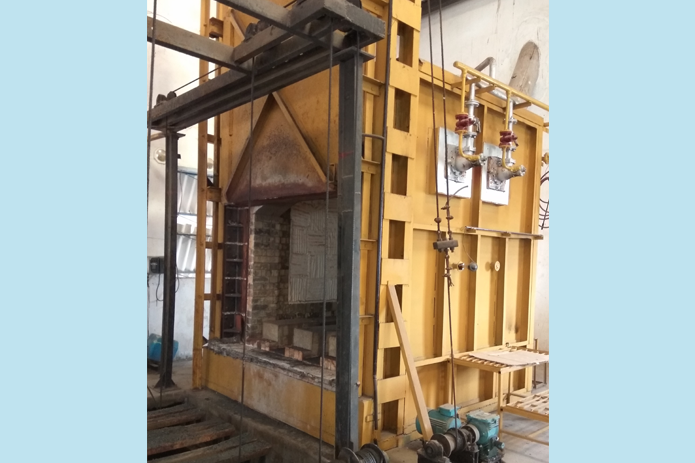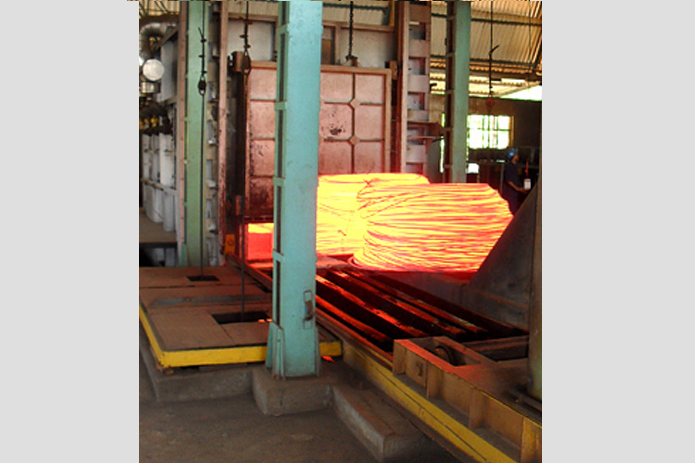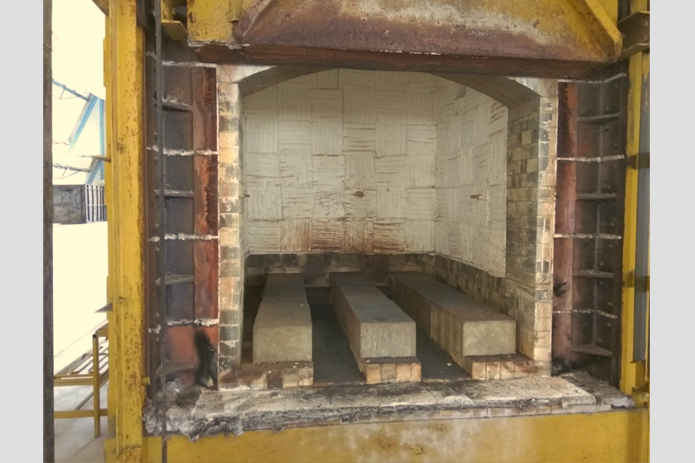


Solution annealing (heating to around 1050°C followed by quenching or rapid cooling) will restore the material to its original condition, removing alloy segregation, sensitization, and restoring ductility after cold working.
Improves the corrosion resistance, Wire drawing ability improves & due to smooth wire drawing, life of die correspondingly improves, Surface defects minimized,Reduction in Pickling time, Improvement & consistency in mechanical / metallurgical properties. This is a batch type fuel fired proven designed furnace with dedicated charging machine, automatic quench operation & fully automatic temperature control system.
Darshika Thermal Engineering Strand as a prominent supplier of Heat Treatment Furnaces, Combustion Equipment and Furnace Spares for all furnace types as well as providing services for furnace revamping, repair and maintenance including mechanical work and refractory lining services. With support from highly experienced manpower and advanced technology, we operate from innovative facilities to ensure that best quality products are offered at competitive prices within realistic delivery timelines.
A solution annealing furnace is a type of heat treatment furnace that is used to improve the mechanical properties of metals. This is achieved through a process called solution annealing which involves heating the metal to a specific temperature and then cooling it down slowly.
This process is used to restore the ductility, toughness and corrosion resistance of metals that have been cold worked or undergo other types of mechanical deformation. It is commonly used in the manufacturing of metals such as stainless steel, aluminum, brass and titanium.
This type of furnace is designed to heat the metal to a temperature that is high enough to allow it to recrystallize or reorganize its atomic structure. This process eliminates the dislocations that were created during the cold working process which improves the ductility and toughness of the materials.
The temperature requirements of the process vary depending on the type of metal being treated. Once the temperature has been reached, the metal is held at that temperature for a set period of time to ensure that the necessary changes in the structure of the materials occur. This time is called as holding time. After the holding period, the metal is then cooled down slowly to prevent unwanted thermal shock from taking place. The cooling rate will depend on the required characteristics of the final product. The said furnace usually features a protective atmosphere which may be a vacuum, a protective gas or atmosphere or a combination of both. This is to protect the metal from oxidation which can weaken the properties of the metal.
Features1.High Temperature Capability: These instruments are designed to reach and maintain high temperatures necessary for dissolving and homogenizing alloying elements in metal components.
2.Controlled Atmosphere: Many models of this type, feature controlled atmosphere systems such as inert gas or vacuum, to facilitate the annealing process by preventing oxidation or other undesired reactions,thereby creating specific environments conducive to the task.
3.Uniform Heating: These furnaces provide uniform heating throughout the work piece, ensuring consistent treatment and preventing localized hot spots that could lead to uneven results.
4.Quenching System: These devices often have integrated quenching systems to rapidly cool the material after heating, aiding in the downpour of phases and achieving the desired metallurgical properties.
5.Programmable Controls: Modern type of such machines feature advanced control systems that allow for precise temperature regulation, heating and cooling rates, ensuring repeatability and consistency.
6.Safety Features: Such machines are equipped with safety mechanisms to prevent overheating, ensure proper ventilation and protect operators from potential hazards associated with high temperature operations.
7.Flexibility in Processing: These furnaces are versatile and can accommodate a variety of metal components, allowing for customization of heat treatment cycles based on specific material requirements.
1.In the stainless steel industry, these devices are employed to treat stainless steel products such as pipes, tubes and fittings. The annealing process helps eliminate carbide deluge and restore the corrosion resistance of the material, ensuring it meets the stringent requirements of various industrial applications including chemical processing, food processing and construction.
2.In the automotive sector, these machines are used to treat various components such as engine parts, gears and shafts, made from materials such as steel and aluminum alloys. By subjecting these components to controlled heating and cooling cycles, the furnaces improve their mechanical properties, ensuring optimal performance in automotive applications.
3.In the aerospace industry, these tools are utilized to treat components such as turbine blades and structural parts made from high strength alloys like titanium and nickel based super alloys. The process helps improve the strength, fatigue resistance and overall performance of the critical aerospace components.
4.These furnaces are integral , particularly in metallurgy, where they play a crucial role in heat treatment processes. They are primarily employed to enhance the mechanical properties of metallic materials.
| Technical Specifications | ||
|---|---|---|
| Nominal Capacity | 1 - 3 Ton / Batch type | |
| Material to be treated | AISI Grade (Coil formed) | |
| Furnace Temperature | 1100ºC | |
| Mode of charging & discharging | By dedicated Charging Machine | |
| Fuel | PNG / L.P.G | |
| Mode of Temp. Control | Automatic through PID & air/gas ratio | |